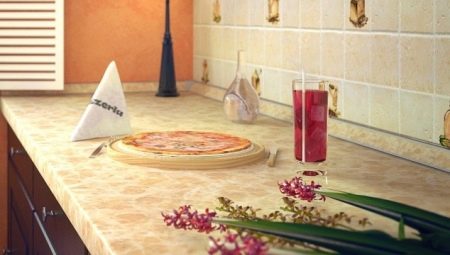The kitchen set includes many elements, thanks to which the interior not only looks holistic, but also is quite functional. One of the rather important, but at first glance very minor elements is the skirting board for countertops.
Let us consider in more detail all the features and functionality of this element.
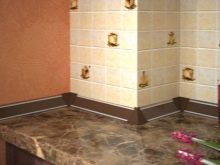
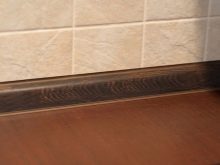
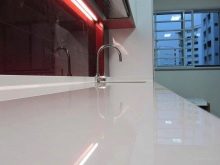
What is it needed for?
Perhaps everyone knows the purpose of skirting boards for the bathroom or floor elements, because they not only decor, but also perform certain obvious functions. Skirting boards for countertops are no exception, since they also carry a certain functionality.
Primarily, this protects the space behind the kitchen cabinets from moisture and food particles. As a rule, kitchen cabinets are either attached to the walls, or are too heavy to move and carry out regular cleaning behind them, so a skirting board that is well and tightly fixed at the junction of the table and wall or wall apron will help prevent crumbs, as well as liquids, which can cause negative impact on wood kitchen unit.

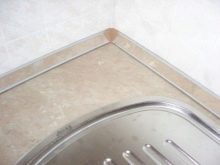
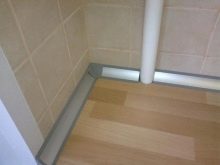
In addition, many models of skirting boards for countertops have an additional functional feature - they are equipped with an internal space for wires.
It will be very useful if your kitchen is equipped with a large number of built-in electrical appliances.
Sure, one cannot fail to mention the decorative feature of this product, because it is one of the most important additions to the kitchen.Some elements, matched to the color of the countertop, look like its decorative continuation, while others, having a certain design, will become a harmonious addition.
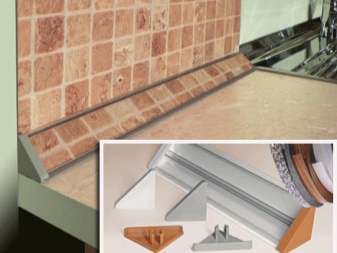
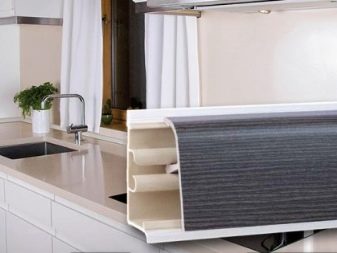
Materials of manufacture
The variety of materials from which skirting boards are made is quite large and allows you to choose the right option for your kitchen. Each material has a number of advantages and disadvantages, therefore It is recommended to familiarize yourself with the characteristics of each of them before buying and installing.
Aluminum baseboard is distinguished by its strength and reliability, since this material is not afraid of cuts or chips. The only damage that may be noticeable on it is surface scratches that do not affect the functional features of the kitchen border.
As for the minuses of this product, then they are reckoned installation complexity, because the aluminum part is not so easy to cut, if suddenly there is such a need.
During installation, it may be necessary to use special sealing means, since in places of loose joining, water or food particles can enter the gap.
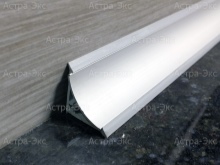
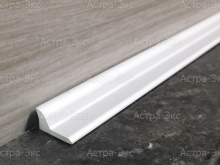
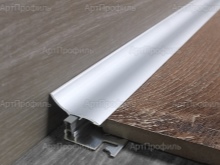
In addition to aluminum products, there are other metal skirting boards. Pretty popular is the product stainless steel, the surface of which is very resistant to moisture in any quantities, but categorically does not tolerate contact with chlorine-containing detergents. In addition, steel skirting boards are often a hidden box for wiring.
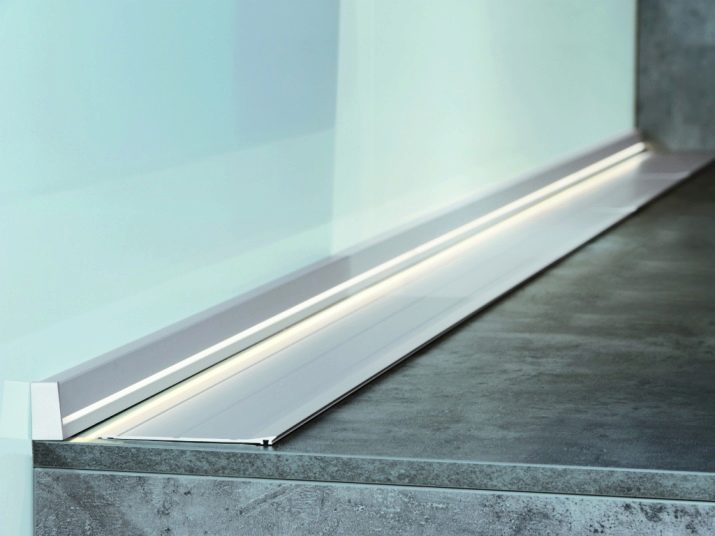
Ceramic products have a more diverse stylistic design, which makes them a great option for absolutely any design of countertops. You can even pick up options that fully match the color of the kitchen set. This is an indisputable advantage of ceramic skirting boards, in addition, they are quite durable and, if handled with care, will last for many years.
Among the minuses are most often noted the occurrence of chips and cracks that can occur with strong impacts. Despite the sufficient strength, ceramic products are still quite unstable to damage of this kind. Also, the installation of products is somewhat more complicated, because they are sold as individual elements 25-30 centimeters long, each of which must not only be glued, but also carefully sealed.

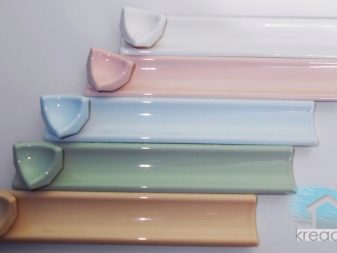
Plastic baseboards are more affordable in price than other options, as well as simpler to install, since they can be easily glued, dismantled or trimmed. Unfortunately, this is where the advantages of plastic products are limited, so you can safely notice that they are quite inferior to others.
One of their most obvious shortcomings is too low strength, because most plastic products can be damaged even by the most ordinary kitchen knife. In addition, the ease of installation still does not provide perfect sealing, since plastic does not catch well with all types of sealants.
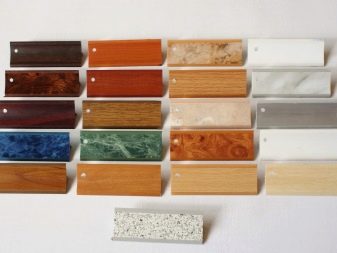

Silicone baseboards are a relatively new trend. This option is most often transparent, quite simple and uniform in design, which makes it almost universal. In addition, silicone products have a very low cost, and are also easily mounted and dismantled.
But problems with them can arise already in the first days of use, since their strength leaves much to be desired, and the sealing properties, despite all the features of their material, are completely absent.
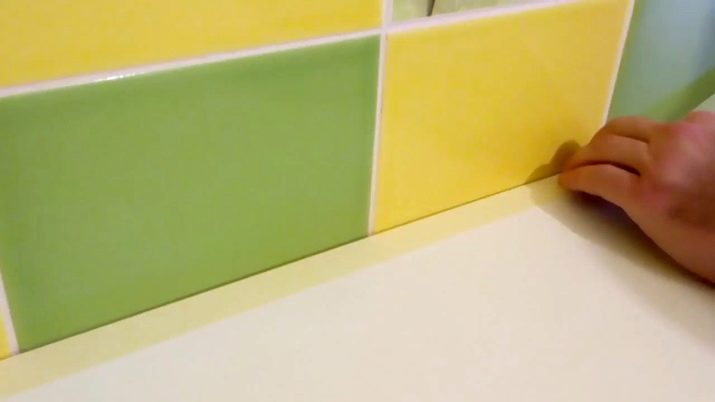
In addition to all the options listed, there are also baseboards made of wood and various types of stones, which are also used for the manufacture of countertops. Typically, such products come with the entire kitchen set and all their characteristics are taken into account at the stage of its manufacture.
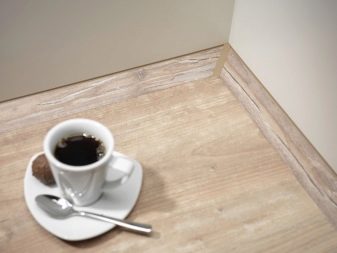
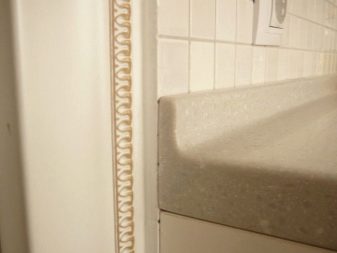
But if there is no doubt about the strength and reliability of stone elements, then wood products cause a lot of questions. First of all, the strength of such skirting boards is in doubt, since it is very easy to damage them with sharp objects. Moreover, with regular contact with water and exposure to high temperatures, a tree may simply begin to break down.
But do not be upset, all these nuances are completely solvable.
To protect the material from moisture and heat, there are many impregnating sprays, varnishes and even paints. And the problem with durability will help to solve the gentle handling and a special rubber coating.
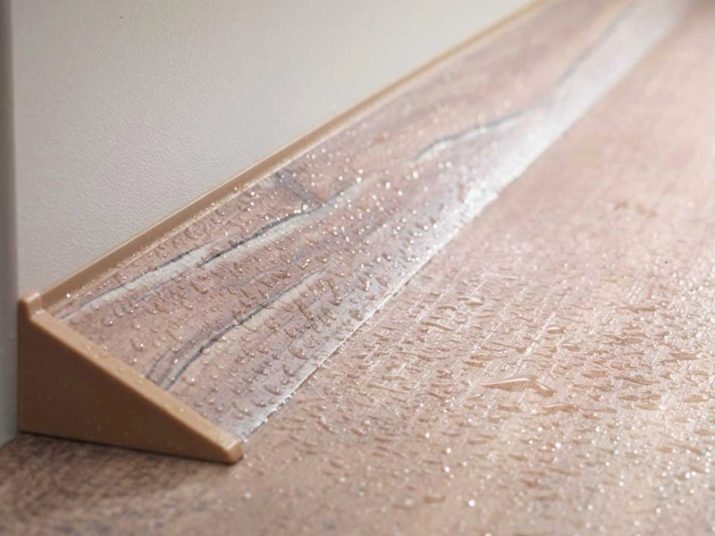
Shapes and sizes
In addition to other distinctive features, there is also a division of skirting boards by type, shape and size, which are suitable for certain kitchen sets and surfaces of countertops.
The shape of the skirting board is divided into several types.
- Figurinese - may have some slight bends and protrusions, which serve only as a decoration, but in no way affect the functionality of the product.
- Square and Rectangular - most often made of metals and are great for hiding wires in them.
- Rounded - represent wall sides having a smooth convex shape. Such models are also great for hiding wiring in them.
- Flat - apply in cases where the distance between the wall and the countertop is minimal and you just need to close this opening. Especially relevant for kitchen sets in a minimalist style.
- Triangular - The classic and most common type of kitchen skirting board, also equipped with a space for wiring. A part of this shape has a right-angled inner corner, which is attached to the surfaces, as well as a smooth inclined outer surface.
- Galtel - shape with small recesses and grooves. This type refers more to decorative elements than to functional ones.
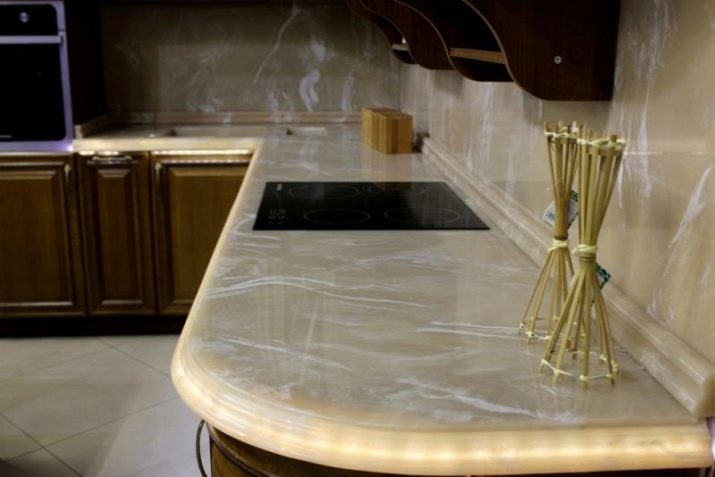
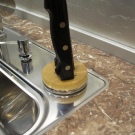


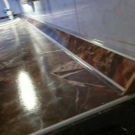
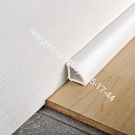
As for the sizes of these products, the most common are the following options.
- As a rule, the width of such products can vary between 1-7 centimeters. The narrowest models are made of silicone, and the widest ones are made of plastic or metal, which makes them more functional.
- The height of such products depends on their width. The wider the outer surface of the baseboard, the higher its angular sides will be.
- Most skirting boards are not separate small elements, but go on sale as long products - up to 4 meters. But it is worth highlighting ceramic models whose maximum length can reach only 30 centimeters, which is why they have to be folded like ceramic tiles.
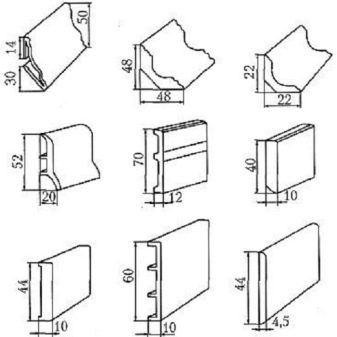
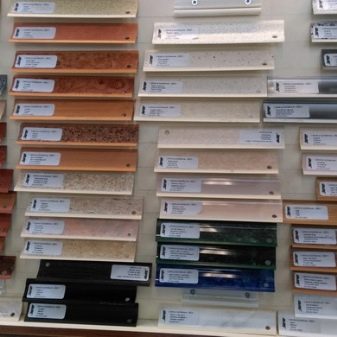
How to choose?
To choose the right skirting board that will not just last you a long time, but it will be in harmony with the countertop, complementing the interior of the entire kitchen, it is necessary to adhere to some recommendations.
- It is necessary to carefully study the characteristics of all the materials used for the manufacture of skirting boards, since often this can be a decisive factor when choosing one or another product.
- In order for the kitchen to be harmonious, it is recommended to choose a skirting board that matches the design of the countertop. And for the maximum functionality of these kitchen elements, you should pay attention to the plinth made of the same material as the countertop, or at least be no less strong.
- It is necessary to take into account the shapes and sizes, so before buying it is important to make all the necessary measurements, choose the right parts for the corner joints, and also decide on the mounting options.
- Attachment methods should be taken care of in advance, because some products can be mounted on small nails, and others on special glue or sealant. It must be borne in mind that both of these mounts have both advantages and disadvantages.
- When choosing, it is necessary to take into account the dimensions of the plinth, namely its width. The greater the distance between the edge of the countertop and the wall, the wider the baseboard should be.
- It is best that the skirting board has heat-resistant properties, especially if it is located in the hob area. The thing is that products that are unstable to high temperatures will quickly deteriorate when exposed to them.
- It is also desirable that the skirting boards are resistant to moisture, so you need to pay attention to the appropriate materials or at least take care of the presence of a moisture-resistant coating.

If you doubt that you can choose the right product yourself, you should contact the professionals.
Proper installation
Installing a kitchen skirting board may not be as easy as it seems at first glance, because if the rules are not followed, the product may come off or become damaged in the first days of use. Therefore, it is recommended to act step by step and sequentially.
- First of all, you need to make sure that you have all the accessories necessary for the installation of this part. It can be small nails, sealing products, adhesive tapes, adhesives and decorative edges.
- Then it is necessary to study the methods of fastening and prepare for them the appropriate conditions. It is also worth completely cleaning the surface of the countertop and walls from dust and debris - no dirt should remain under the baseboard, especially if it has an adhesive base.
- After this, it is necessary to carefully inspect the surfaces into which the kitchen border is to be mounted. If the countertop is too thin or the wall tiles in the kitchen area do not allow fastening with nails, you should fix the baseboard in another way.
- If the surfaces fully allow the option of fastening with nails, then for reliability it is necessary to use it, additionally gluing the joint between the wall and the countertop with adhesive tape or sealant.
- After you decide on the fasteners and prepare the surfaces, it is necessary to make careful measurements and cut off the required length of the plinth, also cutting the corner joint if necessary. You can also use the finished corner.
- After you divide the part into the necessary parts, you can proceed with the direct installation. It is best for two people to do this, because the skirting board will need to be held or properly secured for smooth fixation.
- If the installation is carried out using nails, it is necessary to carefully drive them into the side walls of the baseboards and countertop, constantly checking the position of the part. Nails should be located at a sufficient distance from each other, and the part itself should not bend and puff.
- With adhesive fastening, everything is much simpler - you just need to apply glue to the surface of the countertop and wall or fix the double-sided adhesive tape accordingly. After that, you need to firmly press the baseboard and hold it for a while to fix its position.
- If space remains between the skirting board and the surfaces after installation, it is recommended to treat it with special sealing compounds. It is best to use a transparent agent, carefully walk it over all the cracks and remove the excess. So the baseboard will not only be reliably mounted and protected, but will not stand out from the overall design of the kitchen.
- The final stage of installation is the gluing of a decorative edge, if any.
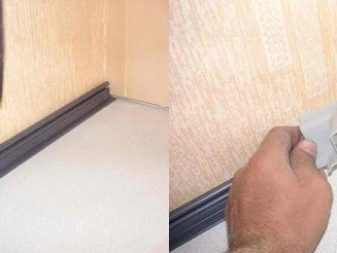
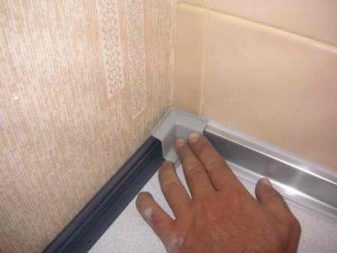
See how to install a kitchen skirting board with your own hands in the video below.
